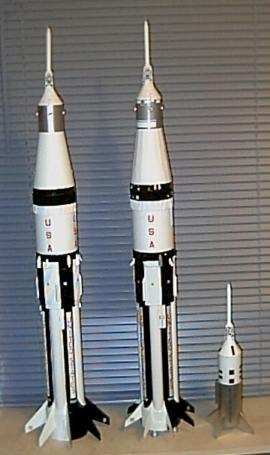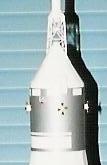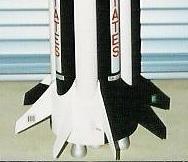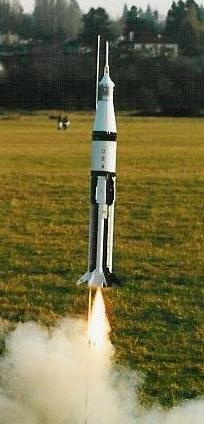| Construction Rating: | starstarstarstarstar |
| Flight Rating: | starstarstarstarstar |
| Overall Rating: | starstarstarstarstar |
| Manufacturer: | Apogee Components  |
| Skill Level: | 5 |
| (L) Estes K-29 Saturn 1B - original restored with Apogee Capsule (M) Apogee Saturn 1B (R) Clone of Estes Little Joe with Apogee Capsule  |
Brief:
The Apogee Saturn 1B is a 1/70th scale model of the 1960’s vintage NASA booster. Originally called the Uprated Saturn before being renamed the Saturn 1B, it was used for unmanned test flights of the Apollo capsule, and to launch the first manned Apollo mission (Apollo 7). It was later used to launch the three Apollo missions to Skylab and finally used for the Apollo/Soyuz mission before being ‘retired’ in 1975. The Apogee Saturn 1B is a companion model to the Apogee 1/70th scale Saturn V, and in fact shares several common parts (you may recall that the S-IVB second stage of the Saturn 1B was the third stage of the Saturn V). I've always been fond of the Saturn 1B – an Estes K-29 "Uprated Saturn" that I put together back in 1968 was the first large, complex rocket I ever built. Besides, I think it looks cool.
 Construction:
Construction:
I ordered my Saturn 1B direct from the Apogee web site (www.apogeerockets.com) shortly after the kit was officially released (you can also order by phone, fax, or snail mail). The kit arrived a few days later, the box literally stuffed full of parts. This is a large, complex kit with 16 body tubes and couplers, three sheets of vacuform parts, three sheets of heavy card stock die-cut centering rings, a plastic Apollo capsule kit, a plastic transition ring, a bag of cast resin fins and detail parts, another bag of plastic J2 engine display nozzles, two nylon parachutes, 2 Kevlar shock cords, 3 ounces of clay nose weight, a decal sheet, some miscellaneous parts, and two CD-ROMs of instructions. T! here is also a nice 20" x 27" color poster of the Apollo/Saturn 1B. Unfortunately when I sat down to inventory the parts, the Kevlar shock cords and a fuel tank centering tube were missing. That was easily solved with a quick e-mail to Apogee explaining the problem – the missing parts showed up in my mailbox a few days later (along with an apology from Apogee owner Tim Van Milligan). Aside from the missing parts, everything arrived in good condition.
As I noted, the instructions are contained on two CD-ROMs, in PDF format. You'll need Adobe Acrobat Reader (to open the instructions file) and QuickTime (to view the video instructions). If you don't already have Acrobat and/or QuickTime, download instructions are included on the CDs. One note – I initially loaded QuickTime version 5.0 on my Windows XP computer and had considerable problems with it (although it worked just fine on my Windows 98 laptop). There is now QuickTime version 6.0, downloading that solved all the problems I experienced with XP.
Although a rather novel approach, the video instructions are excellent (if somewhat time consuming - there are four hours of the video instructions – and occasionally tedious). As something of an added bonus there is also a wonderful collection of Saturn 1B photos and drawings included on the CDs.
 The rocket is built as five major sub-assemblies – the thrust structure/fin unit, the fuel tank tube assembly (which incorporates the engine mount), the S-IVB stage, the LEM Transition/Service Module, and the Apollo Capsule. These sub-assemblies are painted as separate pieces prior to final assembly (this will be familiar to anyone who's built an Estes 2048 Saturn 1B). Given the complexity of the rocket, I found it relatively easy to build – noticeably easier to build than its big brother – the Apogee Saturn V. If you plan to build both the Apogee Saturn 1B and Saturn V, I strongly suggest you build the Saturn 1B first. The lessons learned will come in handy with the Saturn V.
The rocket is built as five major sub-assemblies – the thrust structure/fin unit, the fuel tank tube assembly (which incorporates the engine mount), the S-IVB stage, the LEM Transition/Service Module, and the Apollo Capsule. These sub-assemblies are painted as separate pieces prior to final assembly (this will be familiar to anyone who's built an Estes 2048 Saturn 1B). Given the complexity of the rocket, I found it relatively easy to build – noticeably easier to build than its big brother – the Apogee Saturn V. If you plan to build both the Apogee Saturn 1B and Saturn V, I strongly suggest you build the Saturn 1B first. The lessons learned will come in handy with the Saturn V.
 Unlike other Saturn 1B kits, this kit uses properly scaled fins, so the instructions give you the option of building the Saturn 1B with either ‘straight’ or 2 degree ‘canted’ fins. The canted fins significantly reduce the amount of nose ballast need to insure stability with the relatively small fins. I elected to go with the canted fins, and while it is a little more trouble to build relative to the straight fins, it is visually all but impossible to detect. The cast resin fins are nice and reasonably strong, but mine did have some small air-bubble voids, which were easily filled with some epoxy putty. The video instructions include a step for correcting any defects in the fins. The only part of the Saturn 1B construction that the experienced rocketeer is apt to find new and/or difficult is the attachment of the vacuform wraps. The recommended technique of using thin CA along the edges of the wraps proved troublesome for some people on the Saturn V, so the instructions! also include an alternate method using double backed tape. However I had little difficulty using the thin CA technique – the Saturn 1B wrap edges are simple and straight, without the complex shapes and corners that complicated the process on the Saturn V. I made one minor modification to the stock kit during construction: The kit does not include any sort of engine retention, so I added an AeroTech engine hook to the engine mount assembly.
Unlike other Saturn 1B kits, this kit uses properly scaled fins, so the instructions give you the option of building the Saturn 1B with either ‘straight’ or 2 degree ‘canted’ fins. The canted fins significantly reduce the amount of nose ballast need to insure stability with the relatively small fins. I elected to go with the canted fins, and while it is a little more trouble to build relative to the straight fins, it is visually all but impossible to detect. The cast resin fins are nice and reasonably strong, but mine did have some small air-bubble voids, which were easily filled with some epoxy putty. The video instructions include a step for correcting any defects in the fins. The only part of the Saturn 1B construction that the experienced rocketeer is apt to find new and/or difficult is the attachment of the vacuform wraps. The recommended technique of using thin CA along the edges of the wraps proved troublesome for some people on the Saturn V, so the instructions! also include an alternate method using double backed tape. However I had little difficulty using the thin CA technique – the Saturn 1B wrap edges are simple and straight, without the complex shapes and corners that complicated the process on the Saturn V. I made one minor modification to the stock kit during construction: The kit does not include any sort of engine retention, so I added an AeroTech engine hook to the engine mount assembly.
Finishing:
Although painting the various sub-assemblies separately does help, painting the Saturn 1B may be the most difficult part of building this model. I'm sure I spent at least as much time sanding, painting, and masking my Saturn 1B as I did assembling it. The instructions do a good job of explaining proper techniques on how to get a good finish and how to mask off the model for those tricky roll patterns. The instructions CDs also include a multitude of color drawings showing the correct color scheme and decal placement. But it is still difficult and time consuming to get it right. Some minor quibbles – while all the color drawings are good, it would be nice to have some dimensions – e.g. show that a black band should be X inches wide. Marking and masking the roll patterns on the thrust structure/fin assembly was a major pain – some sort of a painting template might help. I consider the alternating black and white fuel tanks to be almost a trademark of the Saturn 1B, and to make it easy to get the alternating black and white fuel tubes, the tubes are painted separately then glued to the engine mount assembly. While this worked quite nicely, the instructions make no mention that the later Saturn 1Bs (i.e. the Skylab missions) used all white fuel tanks (Apogee has already indicated that they intend to correct this oversight the next time they update the instruction CDs). One other painting suggestion – before you start masking the roll patterns, stop by an automotive paint store and pick up some 3M Scotch brand "Fine Line Tape" and Masking Tape. This stuff is simply fantastic when masking off for painting.
Construction Rating: 5 out of 5

 Flight:
Flight:
The Apogee Saturn 1B is designed for 29 mm motors, however there is not a list of ‘recommended’ motors. When I asked Apogee about this, it was pointed out that there is a trial version of Apogee’s RockSim and the associated S1B data file included on the instruction CDs. While this may be a sneaky way for Tim Van Milligan to get people to try RockSim, it does work (note that you will probably need to edit the rocket weight – the RockSim file lists 12.98 ounces for the Saturn 1B – mine came out closer to 19 ounces, including 1.5 oz. of nose ballast). After a little playing around with RockSim, I selected an AeroTech F40-4W RMS for the maiden flight (RockSim predicted 670 ft. altitude, and ejection within 0.2 seconds of apogee). As I noted earlier, the kit does not provide any method of positive motor retention (instead providing a nicely detailed instruction video on the tried and true masking tape method). However I like the added security of positive motor retention and added an AeroTech engine hook to the engine mount during assembly.
The maiden flight was spectacular. I had angled the launch rod a bit into a gentle wind, so the flight was not quite vertical, but other than that it was nearly perfect to an estimated 600 feet, and both parachutes deployed beautifully shortly after apogee (if you are wondering, when I ran RockSim for the actual launch conditions, it come up with 637 feet and ejection .2 seconds after apogee). The spin from the canted fins was readily apparent, but then again I was watching for it. The rod angle must have been close to perfect as the bottom section of the rocket landed perhaps 30 feet from the launch pad, and the upper portion landed nearly as close. All in all, it was a magnificent and nearly perfect flight
Recovery:
Recovery is by two large nylon parachutes, with the ejection ‘break’ between the S-IVB and the LEM transition. The bottom section uses a 36" parachute, attached by a short Kevlar shock cord. The upper portion makes use of a 24" parachute, attached by a Kevlar harness that holds the Apollo and LEM transition horizontal (to help protect the relatively fragile escape tower from damage on touchdown). I was a bit surprised by the short Kevlar® shock cords, so I asked Apogee about it. They commented that since the two sections recovered separately there was very little risk that "snap-back" would damage the rocket, and hence no need for long shock cords. At any rate it worked fine, and the parachutes are generously sized for the weight of the rocket. Wind drift will typically be of greater concern than landing damage.
Flight Rating: 5 out of 5
Summary:
This is simply a wonderful rocket kit – far and away the nicest Saturn 1B kit I've ever built. The level of detail is terrific, rivaling that of a plastic model, and the scale accuracy has not been sacrificed in making the rocket flight worthy. The video instructions are outstanding (if somewhat tedious at times) and the model is well engineered. The only real down side to this rocket is that those beautiful roll patterns are such a pain to mask and paint. If you are a fan of the Saturn 1B, get this kit – you won't be sorry. The rocket looks awesome in flight and on display - and it looks even better sitting next to an Apogee Saturn V. Now if we could just get Apogee to put together a Little Joe II kit :-).
Overall Rating: 5 out of 5
Other Reviews
- Apogee Components Saturn 1B (1/70th) By Chan Stevens
Let me preface this review by pointing out that I have never paid more than $100 for a rocket, and my previous experience with Apogee and the daunting $175 price for this rocket set my expectations outrageously high. That said, this kit has exceeded them in every way. It is a magnificent kit for the serious modeler, though even moderately experienced modelers will not find this an intimidating ...
 |
 |
Flights
 |
 |
B.B. (January 23, 2003)
Sponsored Ads
 |
 |












B.E. (January 15, 2003)